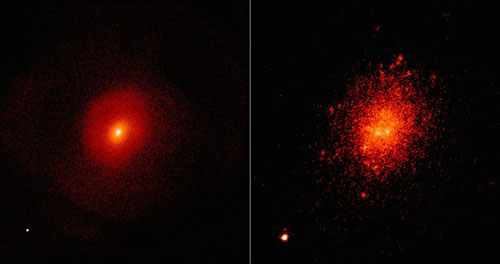 Astronomers have discovered an object in space that might be a black hole catapulted out of a galaxy. Or, according to an alternative interpretation, it might be a giant star that is exploding over an exceptionally long period of several decades. In any case, one thing is certain: This mysterious object is something quite unique, a source of fascination for physicists the world over because of its potential to provide experimental confirmation of the much-discussed gravitational waves predicted by Albert Einstein.
Astronomers have discovered an object in space that might be a black hole catapulted out of a galaxy. Or, according to an alternative interpretation, it might be a giant star that is exploding over an exceptionally long period of several decades. In any case, one thing is certain: This mysterious object is something quite unique, a source of fascination for physicists the world over because of its potential to provide experimental confirmation of the much-discussed gravitational waves predicted by Albert Einstein.
Nov 19th, 2014
Read more
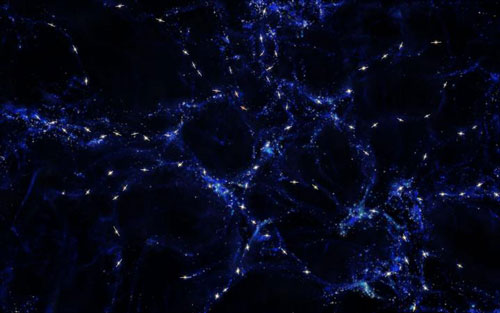 Observations with ESO's Very Large Telescope have revealed alignments over the largest structures ever discovered in the universe. A research team has found that the rotation axes of the central supermassive black holes in a sample of quasars are parallel to each other over distances of billions of light-years. Also found was that the rotation axes of these quasars tend to be aligned with the structures in the cosmic web in which they reside.
Observations with ESO's Very Large Telescope have revealed alignments over the largest structures ever discovered in the universe. A research team has found that the rotation axes of the central supermassive black holes in a sample of quasars are parallel to each other over distances of billions of light-years. Also found was that the rotation axes of these quasars tend to be aligned with the structures in the cosmic web in which they reside.
Nov 19th, 2014
Read more
For years physicists have been looking for the universe's elusive dark matter, but so far no one has seen any trace of it. Maybe we are looking in the wrong place? Now physicists from University of Southern Denmark propose a new technique to detect dark matter.
Nov 18th, 2014
Read more
New research by a team of European physicists could explain why the universe did not collapse immediately after the Big Bang.
Nov 18th, 2014
Read more
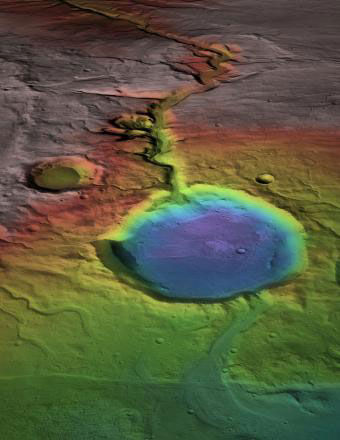 There is ample evidence that water once flowed on the surface of ancient Mars. But that evidence is difficult to reconcile with the latest generation of climate models that suggest Mars should have been eternally icy. A new study suggest that warming and water flow on Mars were probably episodic and related to ancient volcanic eruptions.
There is ample evidence that water once flowed on the surface of ancient Mars. But that evidence is difficult to reconcile with the latest generation of climate models that suggest Mars should have been eternally icy. A new study suggest that warming and water flow on Mars were probably episodic and related to ancient volcanic eruptions.
Nov 17th, 2014
Read more
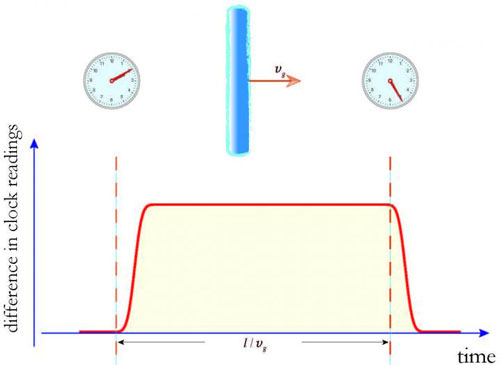 The everyday use of a GPS device might be to find your way around town or even navigate a hiking trail, but for two physicists, the Global Positioning System might be a tool in directly detecting and measuring dark matter, so far an elusive but ubiquitous form of matter responsible for the formation of galaxies.
The everyday use of a GPS device might be to find your way around town or even navigate a hiking trail, but for two physicists, the Global Positioning System might be a tool in directly detecting and measuring dark matter, so far an elusive but ubiquitous form of matter responsible for the formation of galaxies.
Nov 17th, 2014
Read more
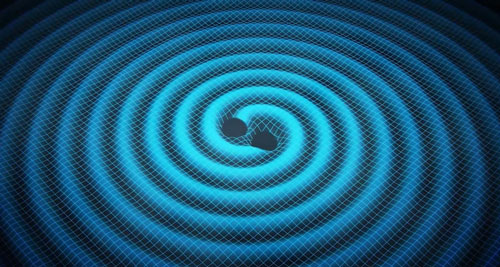 When two detectors are switched on in the US next year, researchers hope their research will help pick up the faint ripples of black hole collisions millions of years ago, known as gravitational waves.
When two detectors are switched on in the US next year, researchers hope their research will help pick up the faint ripples of black hole collisions millions of years ago, known as gravitational waves.
Nov 14th, 2014
Read more
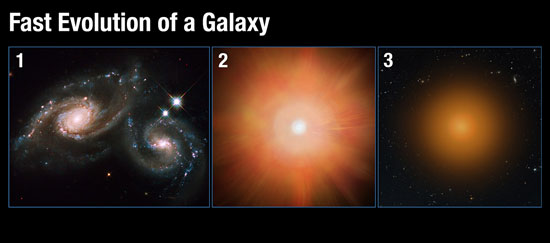 One of the mysteries of the Universe is the question of how all the galaxies we see around us came to be. Astronomers have now uncovered new insights into the processes that have shaped galaxies, using the Hubble Space Telescope and Chandra X-ray Observatory telescope.
One of the mysteries of the Universe is the question of how all the galaxies we see around us came to be. Astronomers have now uncovered new insights into the processes that have shaped galaxies, using the Hubble Space Telescope and Chandra X-ray Observatory telescope.
Nov 14th, 2014
Read more
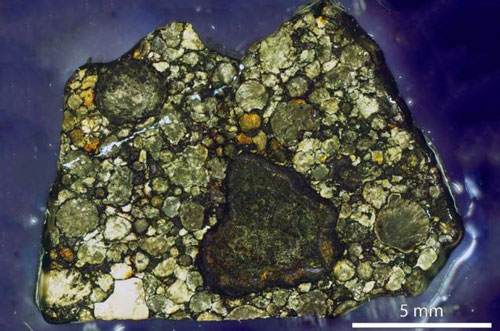 New study finds that a strong magnetic field whipped the early solar system into shape.
New study finds that a strong magnetic field whipped the early solar system into shape.
Nov 14th, 2014
Read more
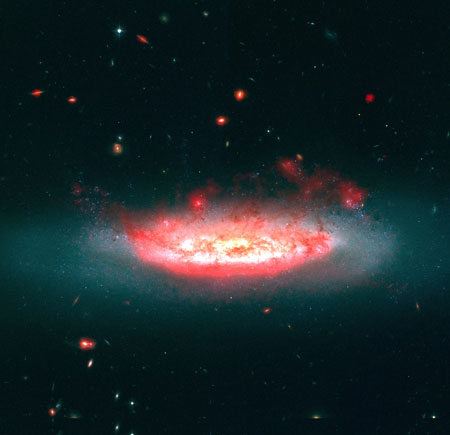 Astronomers have provided the first direct evidence that an intergalactic 'wind' is stripping galaxies of star-forming gas as they fall into clusters of galaxies. The observations help explain why galaxies found in clusters are known to have relatively little gas and less star formation when compared to non-cluster or 'field' galaxies.
Astronomers have provided the first direct evidence that an intergalactic 'wind' is stripping galaxies of star-forming gas as they fall into clusters of galaxies. The observations help explain why galaxies found in clusters are known to have relatively little gas and less star formation when compared to non-cluster or 'field' galaxies.
Nov 13th, 2014
Read more
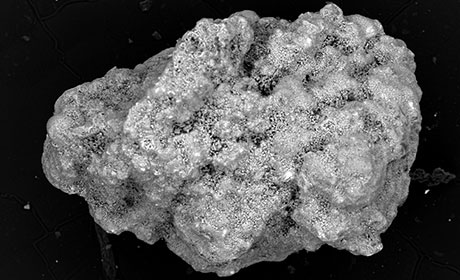 Chloromethane discovered on the Red Planet possibly comes from the Martian soil - meteorites probably provided its carbon and hydrogen.
Chloromethane discovered on the Red Planet possibly comes from the Martian soil - meteorites probably provided its carbon and hydrogen.
Nov 13th, 2014
Read more
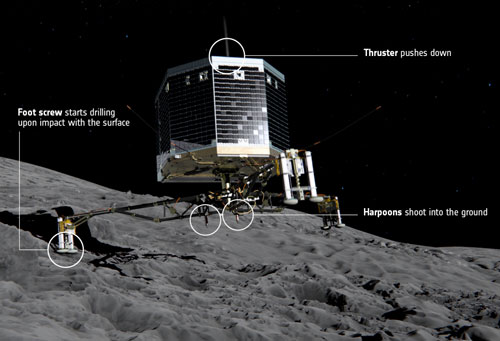 The first attempted landing on the surface of a comet is a huge landmark in the history of space exploration that will not only uncover further details about comets but could unlock further clues about the origins of our solar system and the development of life on Earth.
The first attempted landing on the surface of a comet is a huge landmark in the history of space exploration that will not only uncover further details about comets but could unlock further clues about the origins of our solar system and the development of life on Earth.
Nov 12th, 2014
Read more
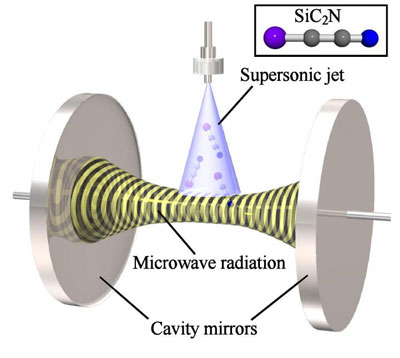 First time laboratory detection of silicon and nitrogen-terminated carbon chain molecules could help astronomers get a more complete picture of interstellar chemistry.
First time laboratory detection of silicon and nitrogen-terminated carbon chain molecules could help astronomers get a more complete picture of interstellar chemistry.
Nov 11th, 2014
Read more
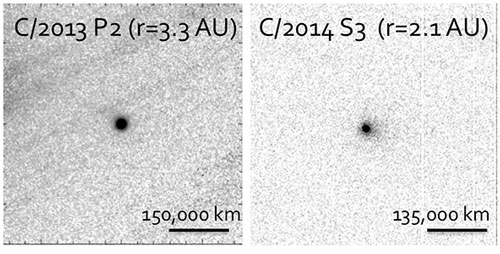 Astronomers are announcing today the discovery of two unusual objects in comet-like orbits that originate in the Oort cloud but with almost no activity, giving scientists a first look at their surfaces. These results are particularly intriguing because the surfaces are different from what astronomers expected.
Astronomers are announcing today the discovery of two unusual objects in comet-like orbits that originate in the Oort cloud but with almost no activity, giving scientists a first look at their surfaces. These results are particularly intriguing because the surfaces are different from what astronomers expected.
Nov 11th, 2014
Read more
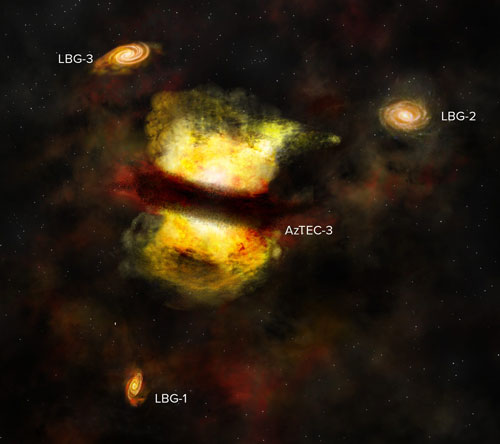 Nestled among a triplet of young galaxies more than 12.5 billion light-years away is a cosmic powerhouse: a galaxy that is producing stars nearly 1,000 times faster than our own Milky Way. This energetic starburst galaxy, known as AzTEC-3, together with its gang of calmer galaxies may represent the best evidence yet that large galaxies grow from the merger of smaller ones in the early Universe, a process known as hierarchical merging.
Nestled among a triplet of young galaxies more than 12.5 billion light-years away is a cosmic powerhouse: a galaxy that is producing stars nearly 1,000 times faster than our own Milky Way. This energetic starburst galaxy, known as AzTEC-3, together with its gang of calmer galaxies may represent the best evidence yet that large galaxies grow from the merger of smaller ones in the early Universe, a process known as hierarchical merging.
Nov 11th, 2014
Read more
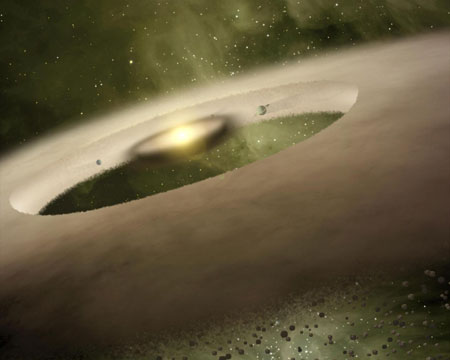 Astronomers have discovered two dust belts surrounded by a large dust halo around young star HD 95086. The findings provide a look back at what our solar system may have resembled in its infancy.
Astronomers have discovered two dust belts surrounded by a large dust halo around young star HD 95086. The findings provide a look back at what our solar system may have resembled in its infancy.
Nov 10th, 2014
Read more
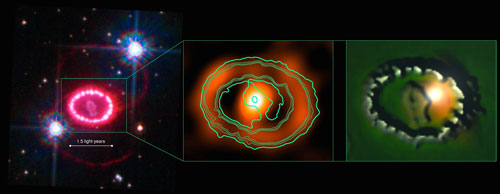 Observations with the ATCA and ALMA radio telescopes have shown signs of something never seen before, located at the center or the remnant of a supernova. It could be a pulsar wind nebula, driven by the spinning neutron star, or pulsar, which astronomers have been searching for since 1987.
Observations with the ATCA and ALMA radio telescopes have shown signs of something never seen before, located at the center or the remnant of a supernova. It could be a pulsar wind nebula, driven by the spinning neutron star, or pulsar, which astronomers have been searching for since 1987.
Nov 10th, 2014
Read more
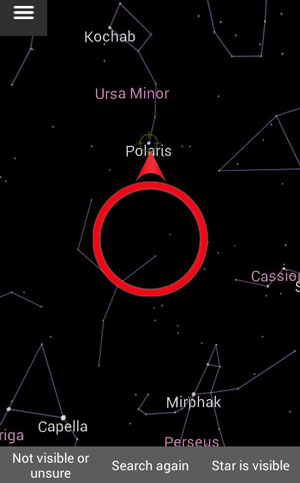 Light pollution is not only a problem for astronomy. Scientists from the interdisciplinary project 'Loss of the Night' study how it affects health, society, and the environment. In order to measure how skyglow is changing, they have developed an app for smartphones, which allows citizen scientists to count the number of visible stars in the night sky.
Light pollution is not only a problem for astronomy. Scientists from the interdisciplinary project 'Loss of the Night' study how it affects health, society, and the environment. In order to measure how skyglow is changing, they have developed an app for smartphones, which allows citizen scientists to count the number of visible stars in the night sky.
Nov 10th, 2014
Read more
 Astronomers have discovered an object in space that might be a black hole catapulted out of a galaxy. Or, according to an alternative interpretation, it might be a giant star that is exploding over an exceptionally long period of several decades. In any case, one thing is certain: This mysterious object is something quite unique, a source of fascination for physicists the world over because of its potential to provide experimental confirmation of the much-discussed gravitational waves predicted by Albert Einstein.
Astronomers have discovered an object in space that might be a black hole catapulted out of a galaxy. Or, according to an alternative interpretation, it might be a giant star that is exploding over an exceptionally long period of several decades. In any case, one thing is certain: This mysterious object is something quite unique, a source of fascination for physicists the world over because of its potential to provide experimental confirmation of the much-discussed gravitational waves predicted by Albert Einstein.
 Subscribe to our Space Exploration News feed
Subscribe to our Space Exploration News feed













